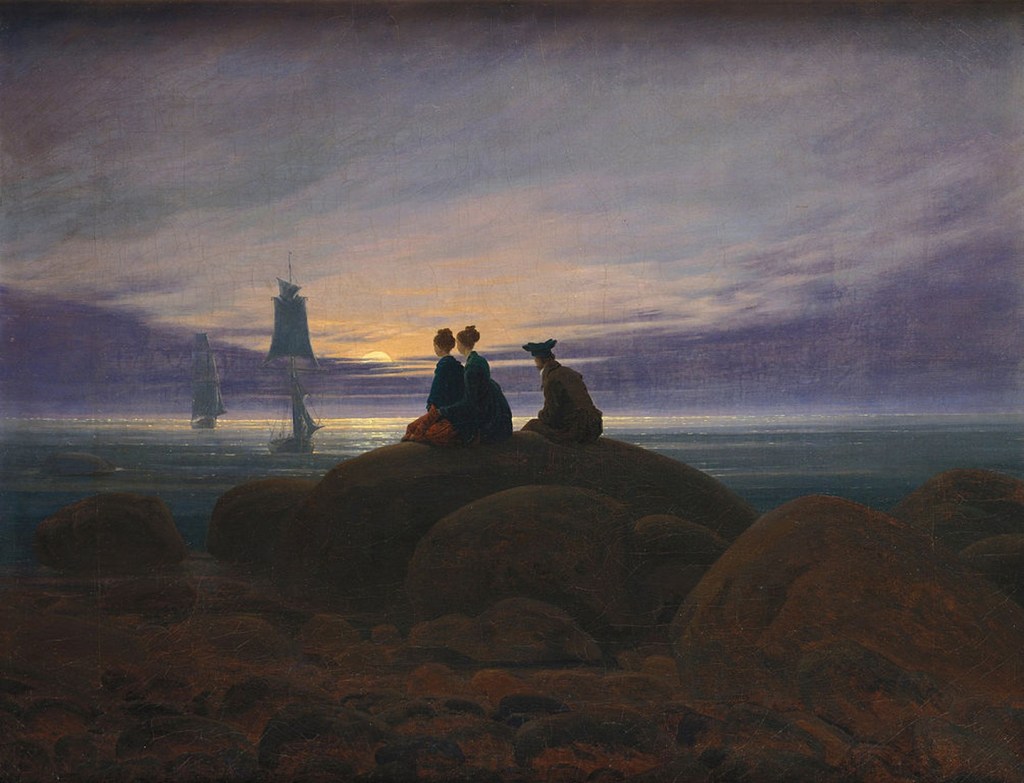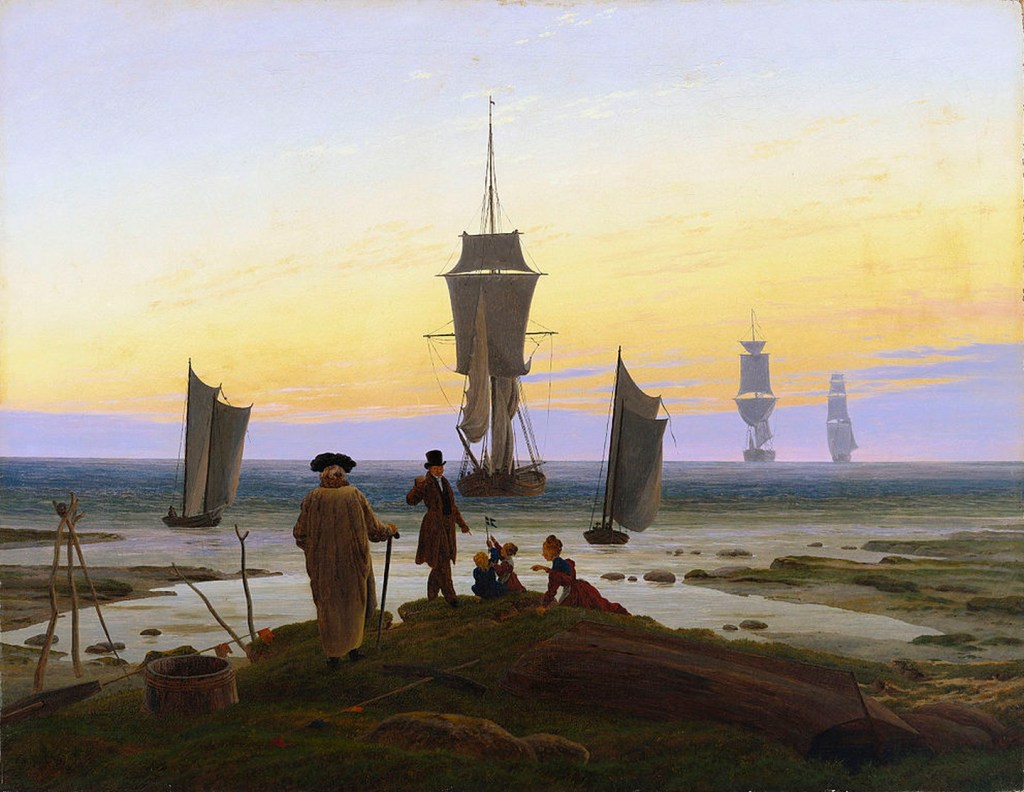“The painter should paint not only what he has in front of him, but also what he sees inside himself”(Caspar David Friedrich).
Caspar David Friedrich (1774 – 1840) was a German Romantic painter, specialising mostly in landscape paintings. In time, his art had become hugely influential, making its mark on the art of others (Arnold Böcklin, Ivan Shishkin) and even on cinematography (Andrey Tarkovsky). Friedrich’s work has been described in many different terms: allegorical, melancholic, sublime, nature-focused, mystical and religious. What is clear, however, is the artist’s desire to convey to the viewer that unfathomable link between the external and the internal worlds that we all experience, and he would use landscape (“moodscape”), symbolism and other devices to convey his impenetrable “philosophy”. He was particularly interested in capturing the “stillness” of a moment/place and tying it to the deeper feelings of longing and wonder at nature, and life and its transience. Below I present five Friedrich’s paintings with some commentary.

I. Chalk Cliffs on Rügen [c. 1818]
In this painting, the artist probably depicted himself, his wife Christiane Caroline Bommer and his brother Christian as this painting was completed just after Friedrich’s honeymoon to the island of Rügen, Germany. The serenity of the Stubbenkammer sea and cliffs contrasts with the activity of the three people in the foreground who find themselves dangerously close to the cliff’s edge.
As seen in other paintings by Friedrich, we can discern a fine symbolism and symmetry in this painting. The overhanging trees work as though a window-frame, presenting to us a lady wearing a red dress, which contrasts with the white cliffs and offsets the dark green and blue dresses of her companions. If the man to the right is completely immobile, standing arms crossed and reclining on what appears to be a dead tree, then the lady is leisurely pointing towards something in the abyss below and is in the sitting position, and the man in the middle (probably the artist himself) is on his hands and knees on the ground, looking in equal wonder at some scene unfolding below. Though the three people find themselves at a short distance from each other, the overall impression is still that of group unity and the three being comfortable around each other, perhaps feeling a little independent at that moment captured by the artist.
Knowing that the painting was completed just after the artist’s honeymoon, it may be safe to assume that he wanted to symbolise the happy unity of two recently joined people: the red dress of the woman may stand for love and bright beginnings, Friedrich, her husband, stands for humility and hard-work as he put his hat on the ground, prepared to be humble and work hard to make his union work, and the motionless man on the right (maybe Friedrich’s brother or moody Friedrich in his youth) is the quiet, melancholic understanding itself. Another common interpretation is that the colours of the dresses of the three characters in the painting (blue, greed and red) stand for the Christian virtues of faith, hope and love respectively. Chalk Cliffs on Rügen is in the permanent collection of the Winterthur Museum of Art in Winterthur, Switzerland.

II. Moonrise over the Sea [c. 1822] (1)
In this painting depicting Friedrich’s birthplace Swedish Pomerania near the Baltic Sea, two women and a man are sitting on a large rock, contemplating the serene sea and the boats. The moon, standing for the mystery, the unknown and even the otherworld, is rising. Hence, the feeling is that of otherworldliness, peacefulness, and beauty found through the silent contemplation of nature. One common interpretation is that the coming-to-shore ships stand for the approaching end to life; the rising moon symbolises the Christ; and the boulders on the beach represent the Christian faith (Helmut Börsch-Supan). Moonrise over the Sea was supposed to be presented alongside Friedrich’s The Lonely Tree, making an “evening/morning” art pair and was commissioned by Joachim Heinrich Wilhelm Wagener. It can be viewed at the Alte Nationalgalerie of the Berlin State Museum, Germany.

III. Moonrise over the Sea (2)
The symmetry of this painting is striking. Two women are sitting in the foreground, looking in the same direction as the two men standing on the rock in the background. They contemplate the calm sea, the boats and the rising moon. As in the painting above, the close proximity of the two women, with one touching the shoulder of another, gives the overall painting a sense of intimacy, but also a feeling of silent understanding and trust (spiritual connection), especially so since the two men and the two women have similar body postures. Characteristically for Friedrich, the men and women in this paining are presented in a diminished perspective (hardly being the main focus) amid one expansive landscape, making the nature’s beauty and the late evening this painting’s central characters. This painting resides in the State Hermitage Museum, Saint-Petersburg, Russia.

IV. On the Sailing Boat [1818]
As the first painting in this post, On the Sailing Boat must be understood in light of Friedrich’s marriage, that took place shortly before the completion of this painting. On the Sailing Boat gives a sense of complete calmness and peacefulness as the two figures (Friedrich and his wife) sit on a sail boat (“a ship of life”), contemplating the journey ahead of them. Through the mist, a distant city can be seen with its church spires. This is probably their coveted destination, all the hopes are pinned on it, and wondrous things await them. Being at the very front of the boat, sitting so close together and holding hands, the couple give the impression of two people that have started their journey in life confidently, fully understanding each other and their union, something that Friedrich undoubtedly wanted to happen in his own marriage. The white sails may be standing for both hope and purity (always the only means to achieve their goal and arrive at their desired destination). This painting can be found in the State Hermitage Museum, Saint-Petersburg, Russia.

V. The Stages of Life [1835]
This is one of Friedrich’s most allegorical paintings which he completed five years prior to his death (hence, life review and mortality were likely to be on the artist’s mind). As the title suggests, The Stages of Life depicts the various stages of human life, from birth, childhood, to old age and then death. What appears to be a family having a fun day out in the harbour at Utkiek, Germany, shows different people at different stages of their lives. The ships in the painting may be standing for the “lives” in the “sea” of the world (Norbert Wolf), and one interpretation is that each ship is “assigned” to each of the figures presented (five people – five ships). The ships also find themselves at difference distances from the coast, which, taking the interpretations of the ships being the “lives” and the coast symbolising common “death”, may suggest that each of the people depicted also find themselves at different degrees of proximity to death. This means that the two ships furthest from the shore represent the children. A more literal interpretation is that naturally this is Friedrich’s own family. The old man is Friedrich himself, the man in the hat is his nephew, the older girl is one of his daughters, and the two children are his son and another daughter. The Stages of Life is on display at the Museum of Fine Art in Leipzig, Germany.


Interesting – The subjects’ backs are always facing the painter. The colors are soothing; especially the harmony between the yellows and violets.
LikeLiked by 2 people
That’s interesting points about the backs facing the painter (it did not actually occur to me before!) and about the colours. I guess Friedrich was interested in depicting the act of observation by others. This still makes his paintings look like landscapes, but also makes them strangely intimate by introducing another person’s point of view/psychology, if I am making any sense. Sorry for the late reply – your comment ended up in my spam folder for some reason and I’ve just retrieved it.
LikeLiked by 1 person
Quite apart from the allegorical interpretations for these paintings – clearly of huge importance for the artist – these work on other levels, whether the purely mundane (views contemporary with the artist), the more psychological (for those who lack faith but still have a sense of the mystical) and appreciation of the compositional and technical skills. Thanks for sharing and adding your commentary.
LikeLiked by 2 people
Definitely. Like any great work, they can be viewed and interpreted in many ways (or not interpreted at all). They can just be seen as curious genre paintings and almost fairy-tale-like landscapes, and those who want to dive deeper, can find other meaning there too.
LikeLiked by 1 person
Thank you for this. I’ve only seen a few of his works and these are stunning – I want to explore more now!
LikeLiked by 3 people
There is a lot to discover. I am finding new works by him constantly and many become my favourites!
LikeLiked by 1 person
A wonderful selection of Friedrich’s work – I always get a sense of his longing for the ineffable in it. And purely on the visual level I’m fascinated by his somewhat off-kilter framing in the Chalk Cliffs. Thank for sharing the works and your thoughts about them.
LikeLiked by 2 people
I think I had never heard of Friedrich’s work before and I am so glad I discovered it thanks to you! All these paintings are so peaceful and quiet, and the soft tones and pastel colours are absolutely beautifuL! I also love how nature seems to have a central part each time! Thanks for sharing 😊
LikeLiked by 2 people